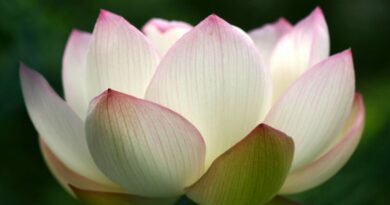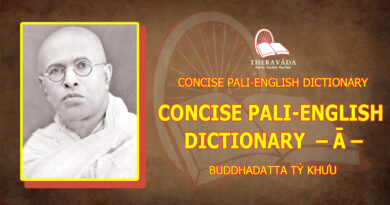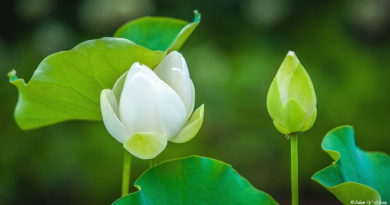Going For Refuge & Taking The Precepts – I. The Reasons For Taking Refuge – Bhikkhu Bodhi
MAIN CONTENT
Going for Refuge
The Buddha’s teaching can be thought of as a kind of building with its own distinct foundation, stories, stairs, and roof. Like any other building the teaching also has a door, and in order to enter it we have to enter through this door. The door of entrance to the teaching of the Buddha is the going for refuge to the Triple Gem — that is, to the Buddha as the fully enlightened teacher, to the Dhamma as the truth taught by him, and to the Sangha as the community of his noble disciples. From ancient times to the present the going for refuge has functioned as the entranceway to the dispensation of the Buddha, giving admission to the rest of the teaching from its lowermost story to its top. All those who embrace the Buddha’s teaching do so by passing through the door of taking refuge, while those already committed regularly reaffirm their conviction by making the same threefold profession:
Buddham saranam gacchami
I go for refuge to the Buddha;Dhammam saranam gacchami
I go for refuge to the Dhamma;Sangham saranam gacchami
I go for refuge to the Sangha.
As slight and commonplace as this step might seem, especially in comparison with the lofty achievements lying beyond, its importance should never be underestimated, as it is this act which imparts direction and forward momentum to the entire practice of the Buddhist path. Since the going for refuge plays such a crucial role it is vital that the act be properly understood both in its own nature and in its implications for future development along the path. To open up the process of going for refuge to the eye of inner understanding, we here present an examination of the process in terms of its most significant aspects. These will be dealt with under the following eight headings: the reasons for taking refuge; the existence of a refuge; the identification of the refuge objects; the act of going for refuge; the function of going for refuge, methods of going for refuge; the corruption and breach of the going for refuge; and the similes for the refuges.
I. The Reasons for Taking Refuge
When it is said that the practice of the Buddha’s teaching starts with taking refuge, this immediately raises an important question. The question is: “What need do we have for a refuge?” A refuge is a person, place, or thing giving protection from harm and danger. So when we begin a practice by going for refuge, this implies that the practice is intended to protect us from harm and danger. Our original question as to the need for a refuge can thus be translated into another question: “What is the harm and danger from which we need to be protected?” If we look at our lives in review we may not see ourselves exposed to any imminent personal danger. Our jobs may be steady, our health good, our families well-provided for, our resources adequate, and all this we may think gives us sufficient reason for considering ourselves secure. In such a case the going for refuge becomes entirely superfluous.
To understand the need for a refuge we must learn to see our position as it really is; that is, to see it accurately and against its total background. From the Buddhist perspective the human situation is similar to an iceberg: a small fraction of its mass appears above the surface, the vast substratum remains below, hidden out of view. Owing to the limits of our mental vision our insight fails to penetrate beneath the surface crust, to see our situation in its underlying depths. But there is no need to speak of what we cannot see; even what is immediately visible to us we rarely perceive with accuracy. The Buddha teaches that cognition is subservient to wish. In subtle ways concealed from ourselves our desires condition our perceptions, twisting them to fit into the mould they themselves want to impose. Thus our minds work by way of selection and exclusion. We take note of those things agreeable to our pre-conceptions; we blot out or distort those that threaten to throw them into disarray.
From the standpoint of a deeper, more comprehensive understanding the sense of security we ordinarily enjoy comes to view as a false security sustained by unawareness and the mind’s capacity for subterfuge. Our position appears impregnable only because of the limitations and distortions of our outlook. The real way to safety, however, lies through correct insight, not through wishful thinking. To reach beyond fear and danger we must sharpen and widen our vision. We have to pierce through the deceptions that lull us into a comfortable complacency, to take a straight look down into the depths of our existence, without turning away uneasily or running after distractions. When we do so, it becomes increasingly clear that we move across a narrow footpath at the edge of a perilous abyss. In the words of the Buddha we are like a traveler passing through a thick forest bordered by a swamp and precipice; like a man swept away by a stream seeking safety by clutching at reeds; like a sailor crossing a turbulent ocean; or like a man pursued by venomous snakes and murderous enemies. The dangers to which we are exposed may not always be immediately evident to us. Very often they are subtle, camouflaged, difficult to detect. But though we may not see them straightaway the plain fact remains that they are there all the same. If we wish to get free from them we must first make the effort to recognize them for what they are. This, however, calls for courage and determination.
On the basis of the Buddha’s teaching the dangers that make the quest for a refuge necessary can be grouped into three general classes: (1) the dangers pertaining to the present life; (2) those pertaining to future lives; and (3) those pertaining to the general course of existence. Each of these in turn involves two aspects: (A) and objective aspect which is a particular feature of the world; and (B) a subjective aspect which is a corresponding feature of our mental constitution. We will now consider each of these in turn.
1. The dangers pertaining to the present life.
A. Objective aspect. The most obvious danger confronting us is the sheer fragility of our physical body and its material supports. From the moment we are born we are subject to disease, accident, and injury. Nature troubles us with disasters such as earthquakes and floods, societal existence with crime, exploitation, repression, and the threat of war. Events on the political, social, and economic fronts rarely pass very long without erupting into crisis. Attempts at reform and revolution always wind up repeating the same old story of stagnation, violence, and consequent disillusionment. Even in times of relative tranquillity the order of our lives is never quite perfect. Something or other always seems to be getting out of focus. Snags and predicaments follow each other endlessly.
Even though we might be fortunate enough to escape the serious adversities there is one we cannot avoid. This is death. We are bound to die, and with all our wealth, expertise, and power we still stand helpless before our inevitable mortality. Death weighs upon us from the time we are born. Every moment brings us closer to the inescapable. As we are drawn along, feeling secure in the midst of our comforts, we are like a man walking across a frozen lake, believing himself safe while the ice is cracking underfoot.
The dangers hanging over us are made even more problematic by their common feature of uncertainty. We have no knowledge when they will take place. If we knew calamity is going to hit we could at least prepare in advance to resign ourselves stoically. But we do not enjoy even this much edge on the future. Because we lack the benefit of foreknowledge our hopes stand up straight, moment after moment, coupled with a vague presentiment that any second, in a flash, they can suddenly be dashed to pieces. Our health might be stricken down by illness, our business fail, our friends turn against us, our loved ones die — we do not know. We can have no guarantee that these reversals will not come upon us. Even death is only certain in that we can be sure it will strike. Exactly when it will strike still remains uncertain.
B. Subjective aspect. The adversities just sketched are objective features built into the world’s constitution. On the one side there is calamity, crisis, and predicament, on the other the radical uncertainty pervading them. The subjective aspect of the danger pertaining to the present life consists in our negative response to this twofold liability.
The element of uncertainty tends to provoke in us a persistent disquietude running beneath our surface self-assurance. At a deep interior level we sense the instability of our reliances, their transience and vulnerability to change, and this awareness produces a nagging apprehensiveness which rises at times to a pitch of anxiety. The source of our disquietude we may not always be able to pinpoint, but it remains lurking in the undercurrent of the mind — an unlocalized fear that our familiar supports will suddenly be stripped away, leaving us without our usual frame of reference.
This anxiety is sufficient disturbance in itself. Yet often our fears are confirmed. The course of events follows a pattern of its own independently of our will, and the two do not necessarily coincide. The world thrown up illness, loss, and death, which strike when the time is ripe. When the course of events clashes with our will the outcome is pain and dissatisfaction. If the conflict is small we become angry, upset, depressed, or annoyed; if it is great we undergo anguish, grief, or despair. In either case a fundamental disharmony emerges from the cleavage between desire and the world, and the result, for us, is suffering.
The suffering that arises is not significant solely in itself. It has a symptomatic value, pointing to some more deeply grounded malady underlying it. This malady lies in our attitude towards the world. We operate out of a mental frame built up of expectations, projections, and demands. We expect reality to conform to our wishes, to submit to our mandates, to confirm our preconceptions, but this it refuses to do. When it refuses we meet pain and disappointment, born from the conflict between expectation and actuality. To escape this suffering one of the two must change, our will or the world. Since we cannot alter the nature of the world to make it harmonize with our will, the only alternative is to change ourselves, by putting away attachment and aversion towards the world. We have to relinquish our clinging, to stop hankering and grasping, to learn to view the fluctuation of events with a detached equanimity free from the swing of elation and dejection.
The mind of equanimity, poised beyond the play of worldly opposites, is the highest safety and security, but to gain this equanimity we stand in need of guidance. The guidance available cannot protect us from objective adversity. It can only safeguard us from the dangers of a negative response — from anxiety, sorrow, frustration, and despair. This is the only protection possible, and because it grants us this essential protection such guidance can be considered a genuine refuge.
This is the first reason for going for refuge — the need for protection from negative reactions to the dangers besetting us here and now.
2. The dangers pertaining to future lives
A. Objective aspect. Our liability to harm and danger does not end with death. From the perspective of the Buddha’s teaching the event of death is the prelude to a new birth and thus the potential passageway to still further suffering. The Buddha teaches that all living beings bound by ignorance and craving are subject to rebirth. So long as the basic drive to go on existing stands intact, the individualized current of existence continues on after death, inheriting the impressions and dispositions accumulated in the previous life. There is no soul to transmigrate from one life to the next, but there is an ongoing stream of consciousness which springs up following death in a new form appropriate to its own dominant tendencies.
Rebirth, according to Buddhism, can take place in any of six realms of becoming. The lowest of the six is the hells, regions of severe pain and torment where evil actions receive their due expiation. Then comes the animal kingdom where suffering prevails and brute force is the ruling power. Next is the realm of “hungry ghosts” (petavisaya), shadowy beings afflicted with strong desires they can never satisfy. Above them is the human world, with its familiar balance of happiness and suffering, virtue and evil. Then comes the world of the demi-gods (asuras), titanic beings obsessed by jealousy and ambition. And at the top stands the heavenly worlds inhabited by the devas or gods.
The first three realms of rebirth — the hells, the animal kingdom, and the realm of ghosts — together with the asuras, are called the “evil destinations” (duggati) or “plane of misery” (apayabhumi). They receive these names because of the preponderance of suffering found in them. The human world and the heavenly worlds are called, in contrast, the “happy destinations” (sugati) since they contain a preponderance of happiness. Rebirth in the evil destinations is considered especially unfortunate not only because of the intrinsic suffering they involve, but for another reason as well. Rebirth there is calamitous because escape from the evil destinations is extremely difficult. A fortunate rebirth depends on the performance of meritorious actions, but the beings in the evil destinations find little opportunity to acquire merit; thence the suffering in these realms tends to perpetuate itself in a circle very difficult to break. The Buddha says that if a yoke with a single hole was floating at random on the sea, and a blind turtle living in the sea were to surface once every hundred years — the likelihood of the turtle pushing his neck through the hole in the yoke would be greater than that of a being in the evil destinations regaining human status. For these two reasons — because of their inherent misery and because of the difficulty of escaping from them — rebirth in the evil destinations is a grave danger pertaining to the future life, from which we need protection.
B. Subjective aspect. Protection from a fall into the plane of misery cannot be obtained from others. It can only be obtained by avoiding the causes leading to an unfortunate rebirth. The cause for rebirth into any specific plane of existence lies in our kamma, that is, our willed actions and volitions. Kamma divides into two classes, the wholesome and the unwholesome. The former are actions motivated by detachment, kindness, and understanding, the latter actions motivated by greed, hatred and delusion. These two classes of kamma generate rebirth into the two general planes of existence: wholesome kamma brings rebirth into the happy destinations, unwholesome kamma brings rebirth into the evil destinations.
We cannot obliterate the evil destinations themselves; they will continue on as long as the world itself endures. To avoid rebirth in these realms we can only keep watch over ourselves, by controlling our actions so that they do not spill over into the unwholesome courses leading to a plunge into the plane of misery. But to avoid generating unwholesome kamma we need help, and that for two principal reasons.
First, we need help because the avenues of action open to us are so varied and numerous that we often do not know which way to turn. Some actions are obviously wholesome or unwholesome, but others are difficult to evaluate, throwing us into perplexity when we run up against them. To choose correctly we require guidance — the clear indications of one who knows the ethical value of all actions and the pathways leading to the different realms of being.
The second reason we need help is because, even when we can discriminate right from wrong, we are often driven to pursue the wrong against our better judgment. Our actions do not always follow the counsel of our dispassionate decisions. They are often impulsive, driven by irrational urges we cannot master or control. By yielding to these drives we work our own harm even while helplessly watching ourselves do so. We have to gain mastery over our mind, to bring our capacity for action under the control of our sense of higher wisdom. But this is a task which requires discipline. To learn the right course of discipline we need the instructions of one who understands the subtle workings of the mind and can teach us how to conquer the obsessions which drive us into unhealthy self-destructive patterns of behavior. Because these instructions and the one who gives them help protect us from future harm and suffering, they can be considered a genuine refuge.
This is the second reason for going for refuge — the need to achieve mastery over our capacity for action so as to avoid falling into the evil destinations in future lives.
3. The dangers pertaining to the general course of existence
A. Objective aspect. The perils to which we are exposed are immensely greater than those just discussed. Beyond the evident adversities and misfortunes of the present life and the risk of a fall into the plane of misery, there is a more fundamental and comprehensive danger running through the entire course of worldly existence. This is the intrinsic unsatisfactoriness of samsara. Samsara is the cycle of becoming, the round of birth, aging and death, which has been revolving through beginningless time. Rebirth does not take place only once, leading to an eternity in the life to come. The life-process repeats itself over and over, the whole pattern spelling itself out again and total with each new turn: each single birth issues in decay and death, each single death gives way to a new birth. Rebirth can be fortunate or miserable, but wherever it occurs no halt is made to the revolution of the wheel. The law of impermanence imposes its decree upon the entire domain of sentient life; whatever arises must eventually cease. Even the heavens provide no outlet; life there also ends when the kamma that brought a heavenly birth is exhausted, to be followed by a re-arising in some other plane, perhaps in the miserable abodes.
Because of this pervasive transience all forms of conditioned existence appear to the eye of wisdom as essentially dukkha, unsatisfactory or suffering. None of our supports and reliances is exempt from the necessity to change and pass away. Thence what we resort to for comfort and enjoyment is in reality a concealed form of suffering; what we rely on for security is itself exposed to danger; what we turn to for protection itself needs to be protected. Nothing that we want to hold to can be held onto forever, without perishing: “It is crumbling away, it is crumbling away, therefore it is called ‘the world’.”
Youth issues in old age, health in sickness, life in death. All union ends in separation, and in the pain that accompanies separation. But to understand the situation in its full depth and gravity we must multiply it by infinity. From time without beginning we have been transmigrating through the round of existence, encountering the same experiences again and again with vertiginous frequency: birth, aging, sickness and death, separation and loss, failure and frustration. Repeatedly we have made the plunge into the plane of misery; times beyond counting we have been animal, ghost, and denizen of hell. Over and over we have experienced suffering, violence, grief, despair. The Buddha declares that the amount of tears and blood we have shed in the course of our samsaric wandering is greater than the waters in the ocean; the bones we have left behind could form a heap higher than the Himalaya mountains. We have met this suffering countless times in the past, and as long as the causes of our cycling in samsara are not cut off we risk meeting more of the same in the course of our future wandering.
B. Subjective aspect. To escape from these dangers there is only one way of release: to turn away from all forms of existence, even the most sublime. But for the turning away to be effective we must cut off the causes that hold us in bondage to the round. The basic causes that sustain our wandering in samsara lie within ourselves. We roam from life to life, the Buddha teaches, because we are driven by a profound insatiable urge for the perpetuation of our being. This urge the Buddha calls bhava-tanha, the craving for existence. While craving for existence remains operative, even if only latently, death itself is no barrier to the continuation of the life-process. Craving will bridge the vacuum created by death, generating a new form of existence determined by the previously accumulated storage of kamma. Thus craving and existence sustain each other in succession. Craving brings forth a new existence; the new existence gives the ground for craving to resume its search for gratification.
Underlying this vicious nexus which links together craving and repeated existence is a still more primordial factor called “ignorance” (avijja). Ignorance is a basic unawareness of the true nature of things, a beginningless state of spiritual unknowing. The unawareness operates in two distinct ways: on one side it obscures correct cognition, on the other it creates a net of cognitive and perceptual distortions. Owing to ignorance we see beauty in things that are really repulsive, permanence in the impermanent, pleasure in the unpleasurable, and selfhood in selfless, transient, unsubstantial phenomena. These delusions sustain the forward drive of craving. Like a donkey chasing a carrot suspended from a cart, dangling before its face, we rush headlong after the appearances of beauty, permanence, pleasure and selfhood, only to find ourselves still empty-handed, more tightly entangled in the samsaric round.
To be freed from this futile and profitless pattern it is necessary to eradicate the craving that keeps it in motion, not merely temporarily but permanently and completely. To eradicate craving the ignorance which supports it has to be dislodged, for as long as ignorance is allowed to weave its illusions the ground is present for craving to revive. The antidote to ignorance is wisdom (pañña). Wisdom is the penetrating knowledge which tears aside the veils of ignorance in order to “see things as they really are.” It is not mere conceptual knowledge, but an experience that must be generated in ourselves; it has to be made direct, immediate and personal. To arouse this wisdom we need instruction, help, and guidance — someone who will teach us what we must understand and see for ourselves, and the methods by which we can arouse the liberating wisdom that will cut the cords binding us to repeated becoming. Since those who give this guidance, and the instructions themselves, provide protection from the perils of transmigration they can be considered a genuine refuge.
This is the third reason for going for refuge — the need for deliverance from the pervasive unsatisfactoriness of Samsara.









